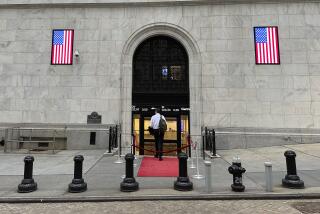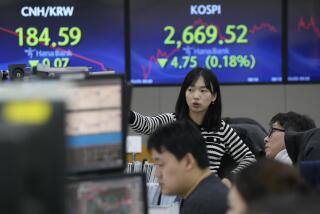ON THE FRITZ : After Two Years of Heady Growth, Computer Firms Have Hit Hard Times, With No Relief in Sight
The first inkling of bad news came last August from W. Jerry Sanders, chairman of Advanced Micro Devices. In a pronouncement reminiscent of Chicken Little’s “the sky is falling,” the flamboyant high-tech entrepreneur said an abrupt slowdown in semiconductor orders from personal computer manufacturers signaled nothing less than a downturn for the entire industry.
Sanders’ predictions were immediately dismissed as preposterous and hysterical. Few in the computer industry wanted to hear, let alone believe, that the future could be any less glorious than the previous two years.
But Sanders has proven to be remarkably prescient. Not since the severe slump of 1985-86 has the computer industry been hit with such a stream of plant closings, large-scale employee layoffs, evaporating profits and disappointing sales.
And crystal ball gazers are finding few reasons to be any more hopeful about the immediate future.
“Generally speaking, we are looking at a slowdown,” said Robert Charlton, an analyst with Dataquest, a high-tech market research firm. “All companies are going to feel some effects.”
In the last six months, chip makers National Semiconductor and Intel, computer manufacturers ranging from IBM and Apple Computer to low-end clone-maker Leading Edge and software publishers such as Microsoft all have reported financial setbacks. Unisys became the latest to chime in when it said late last month that it expects to post a loss of up to $80 million due to an “aberration” in its business operations.
Although many industry executives still argue that these developments reflect problems at individual companies rather than an industrywide slump, a rising chorus of analysts is beginning to suggest otherwise.
Their assessment: The market for computers and related office automation systems, which enjoyed explosive growth for the last two years, is now expanding more slowly because of creeping inflation, worries about the economy among corporate purchasing managers and a natural pause in buying while software programmers and customers alike catch up with the latest technology advances.
Michele Preston, a personal computer market analyst with Salomon Bros. in New York, sees some striking similarities between the current climate and that of 1985-86.
As in the previous slowdown, Preston noted, the industry is coming off a tremendous boom that lured scores of new companies and products into the market. Not surprisingly, she added, “We now have too many companies again and there is another shakeout under way. The plain fact is that there are some companies that aren’t going to be around for much longer.”
Already, Leading Edge has filed for bankruptcy protection. And last week Wyse Technology revealed that its lenders agreed to waive some their loan requirements because the company’s recent losses have eroded its assets.
Compounding the problem for some companies are earlier-laid plans to launch new products into what they thought would be a red-hot market. Despite the cooling, the product introductions continue at a boggling rate, in large part, analysts say, because companies want to protect their market shares and technology know-how. In the last two months alone, virtually every major computer manufacturer has introduced new products, ranging from entirely new systems to relatively unexciting product upgrades.
Nevertheless, International Data Corp., a Framingham, Mass., market research firm, predicts that sales of all types of computers in the United States will grow by just 3% this year, compared to 7% last year. The Commerce Department also is predicting slower growth. Commerce, however, is predicting a 10% increase in U.S. computer industry shipments this year, to about $67 billion, compared to a 14% increase in 1988.
Even though sales continue to rise, analysts say the slower growth rate means that companies can’t get away with some of the missteps they could in the past.
“The last two years have been boom times,” said Stewart Alsop, publisher of a personal computer newsletter in the Silicon Valley. “A lot of sins were hidden by that.”
So far, the slowdown, which has invaded most segments of the computer industry, has been most apparent in the personal computer market. Analysts say the industry’s relative immaturity and heavy competition, as well as rapid advances that quickly make products obsolete, make PCs among the most vulnerable segment of the technology market when consumers’ purse strings suddenly tighten.
Another important influence is the growing supply of low-cost PCs imported from Japan, Taiwan and South Korea. These systems are competing head-on with comparable machines produced by several U.S. companies, notably Wyse Technology, AST Research and Dell Computer.
When the entire market was rapidly expanding, the additional competition wasn’t so troublesome. But as buying slows, the fighting over market share intensifies.
According to Dataquest, PC sales growth in the United States, which has averaged more than 25% for the last two years, should remain under 10% for at least the next three or four years.
However, as disturbing as the trend might be to those in the industry, consumers should be pleased. Price competition, analysts say, has reached a new peak, making 1989 one of the best years in recent times to find a personal computer bargain.
Sadder, Wiser
“I would think this would be a very good year to buy,” said Dataquest’s Charlton.
Last year, booming demand and a shortage of all-important dynamic random access memory chips led several computer makers to raise prices substantially. But almost all of them have been forced in recent months to lower prices to pump sagging sales.
“A year ago we were enthusiastic about our sales prospects and we raised prices,” said a sadder-but-wiser Thomas Yuen, co-founder and marketing vice president at AST Research, the Irvine personal computer maker. “We learned our lesson.”
In the ensuing year, the company has twice cut the prices of its systems. Still, it was not enough to repair all the damage. The company laid off 120 workers earlier this year and announced its first-ever quarterly loss.
AST isn’t alone is resorting to layoffs. Advanced Micro Devices recently has laid off more than 2,000 workers; National Semiconductor has dropped about 2,000 employees, and Unisys is eliminating the jobs of 2,500.
Even where the price cuts have sparked some increased buying, analysts say they do nothing to solve two far more fundamental problems: the ongoing customer confusion over competing technologies and the growing gulf between the technological capabilities of a computer and the available software to operate on the machines.
For example, industry pundits note that Intel’s newest and fastest-ever microprocessor, the model 80486, will make its debut in personal computers later this year. Yet very little software exists today that takes full advantage of the technological innovations Intel built into its 80286 chip that was released a full five years and two generations of PCs ago.
Analysts say it will take some exciting new software to draw customers, particularly corporate buyers looking to increase office productivity, back into the market. They note how the Lotus 1-2-3 spreadsheet program spurred early sales of the IBM personal computer. And it was the whole new field of desktop publishing and related graphics programs that fueled the eventual surge in sales of Apple’s Macintosh computers.
“They need new software now to create the same kind of customer demand,” said Bruce Lupatkin, an analyst with Hambrecht & Quist, a San Francisco brokerage.
Customers Confused
Added Kenneth Flamm, a computer industry analyst for the Brookings Institute: “The growth in demand in this industry has always been lumpy, but I think the market is now waiting for new technologies. Once they come along, there will be a flood of demand.”
HOT DEALS IN A COOL MARKET It can hardly be considered a fire sale, but prices of many personal computer models have dropped steadily in recent months as manufacturers have tried to spur sales. The price cuts also reflect the declining prices of dynamic random access memory chips, a key memory component that was in short supply last year.
Although declining prices of older model computers have been a regular feature of the industry over the years, analysts say the recent price cuts stem in large part from softening demand.
Product Price April, ’88 Price March, ’89 Mac Plus $1,295 $1,229 Mac II 3,775 3,699 IBM PS/2-50 2,479 2,295 AST Premium/286 1,995 1,449 Compaq Deskpro 1,998 1,695 Leading Edge 286 1,798 1,448 AST Premium/386 4,195 2,650 IBM PS/2-40 3,999 3,996 Toshiba T1200 2,125 1,988
Source: The Wohl Report, Bala Cynwyd, Pa. Based on actual retail price surveys conducted in major metropolitan areas.






